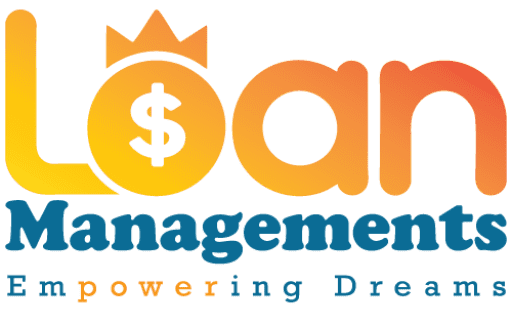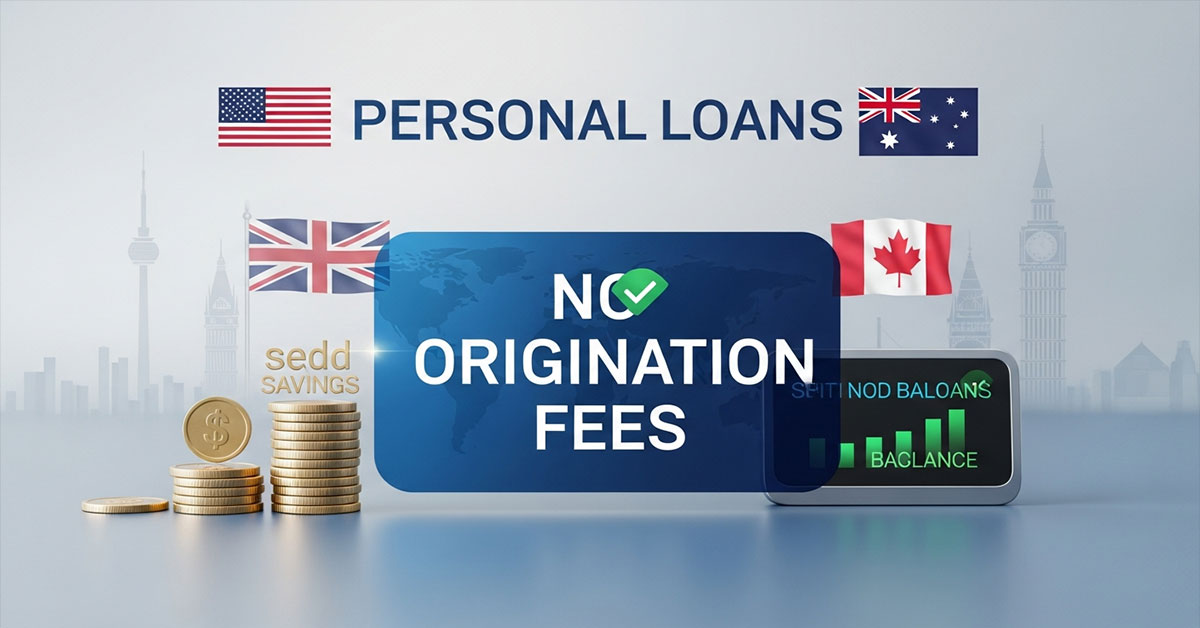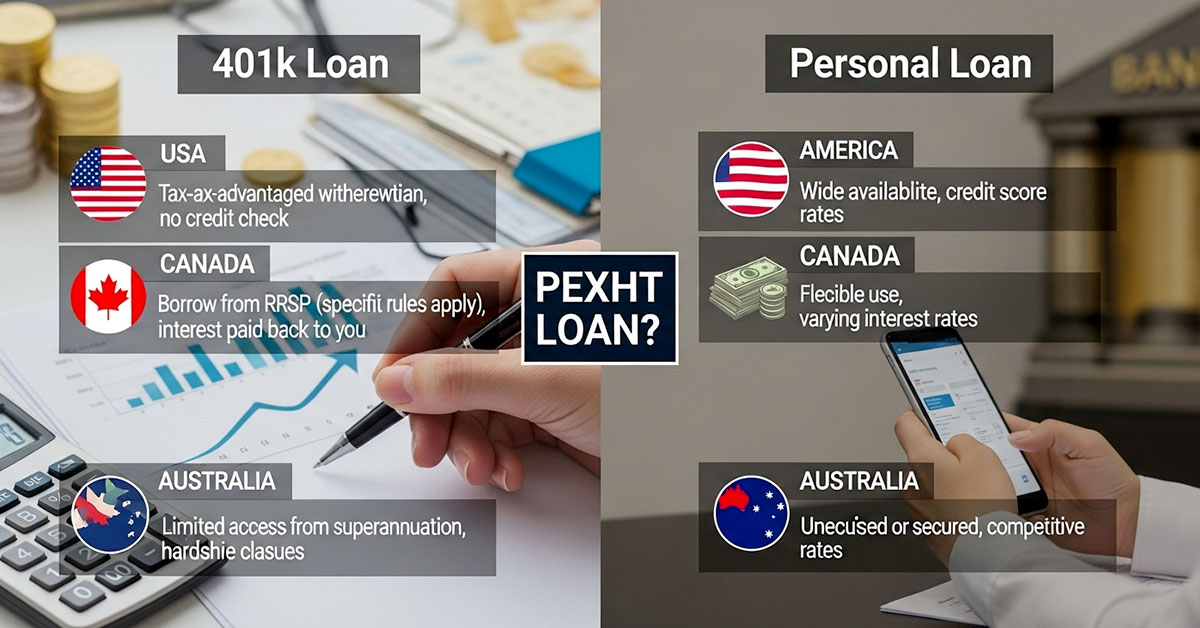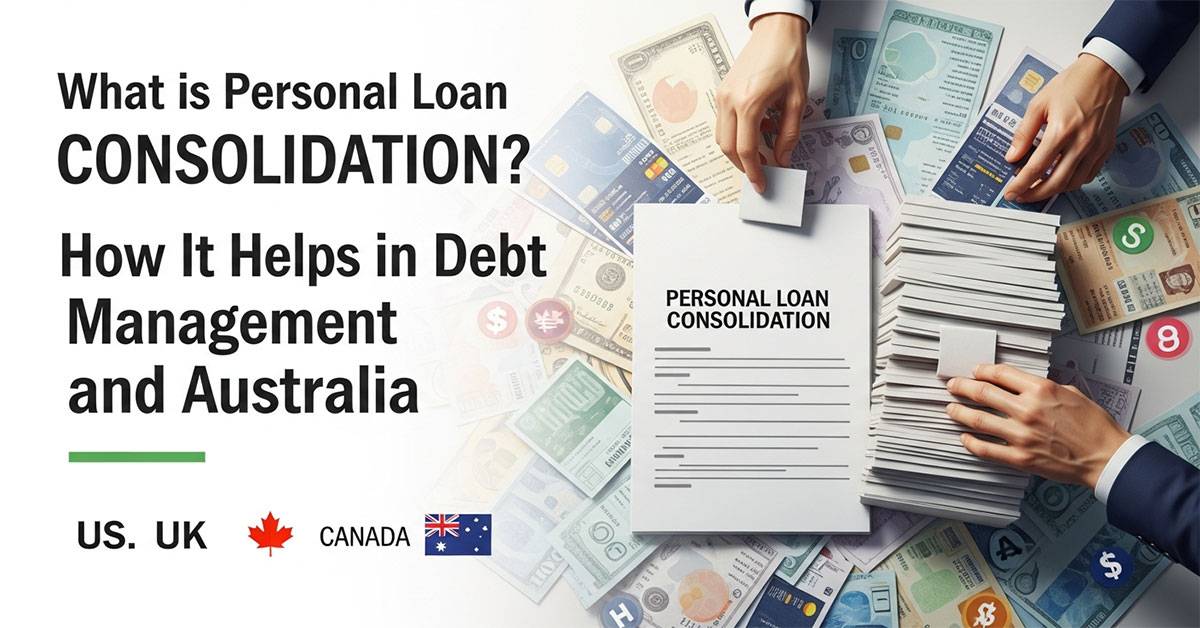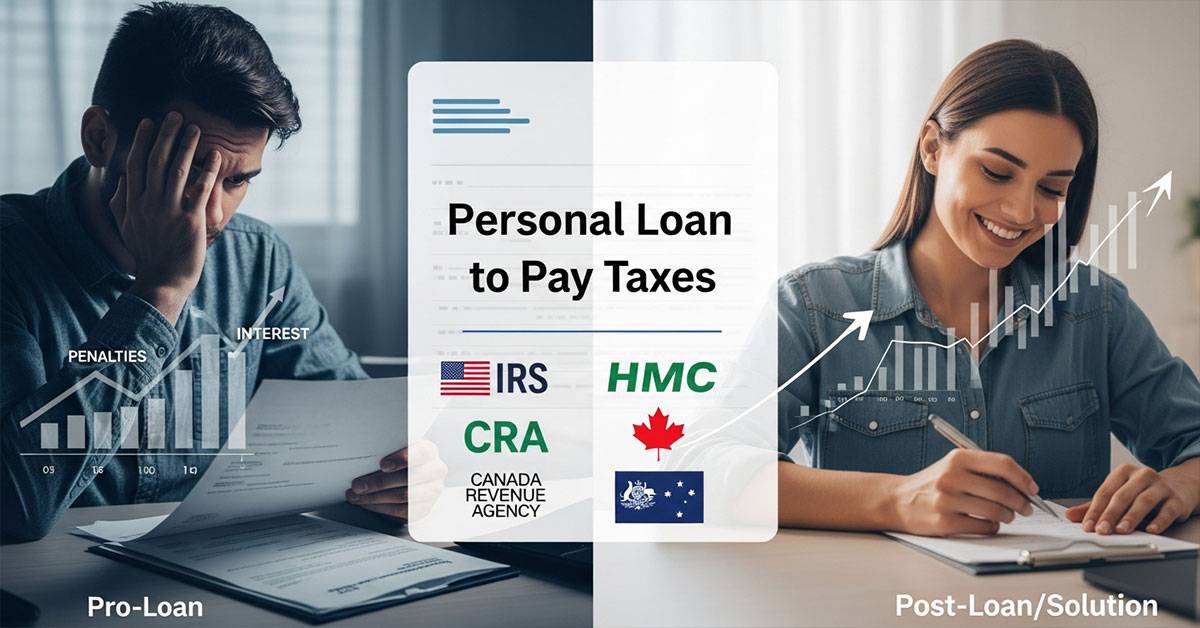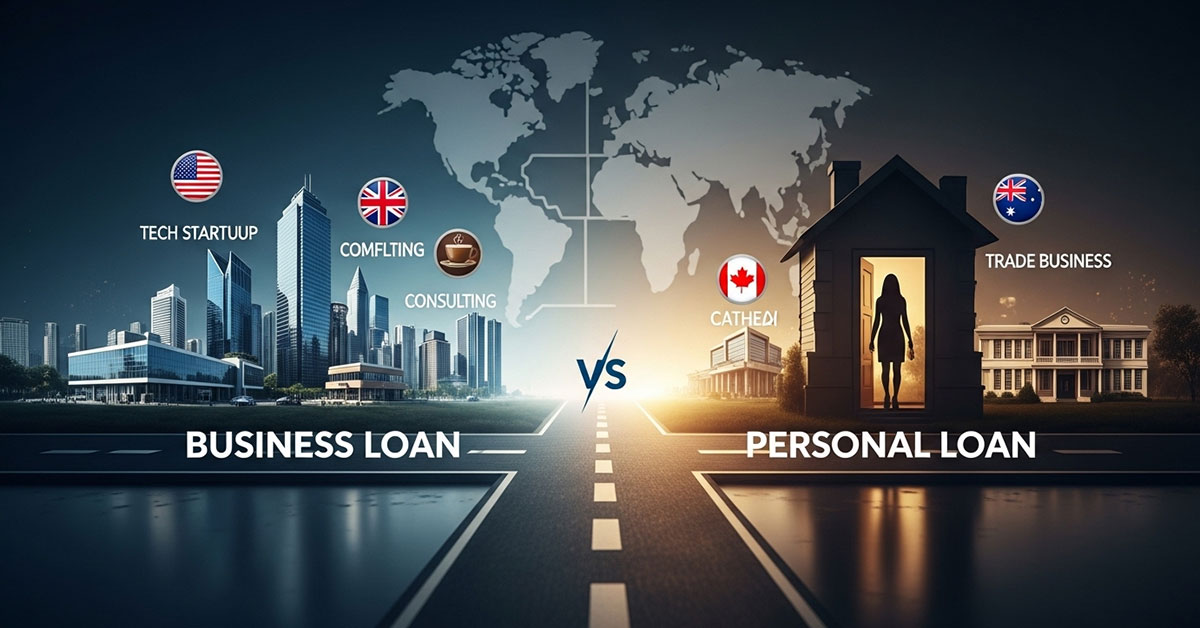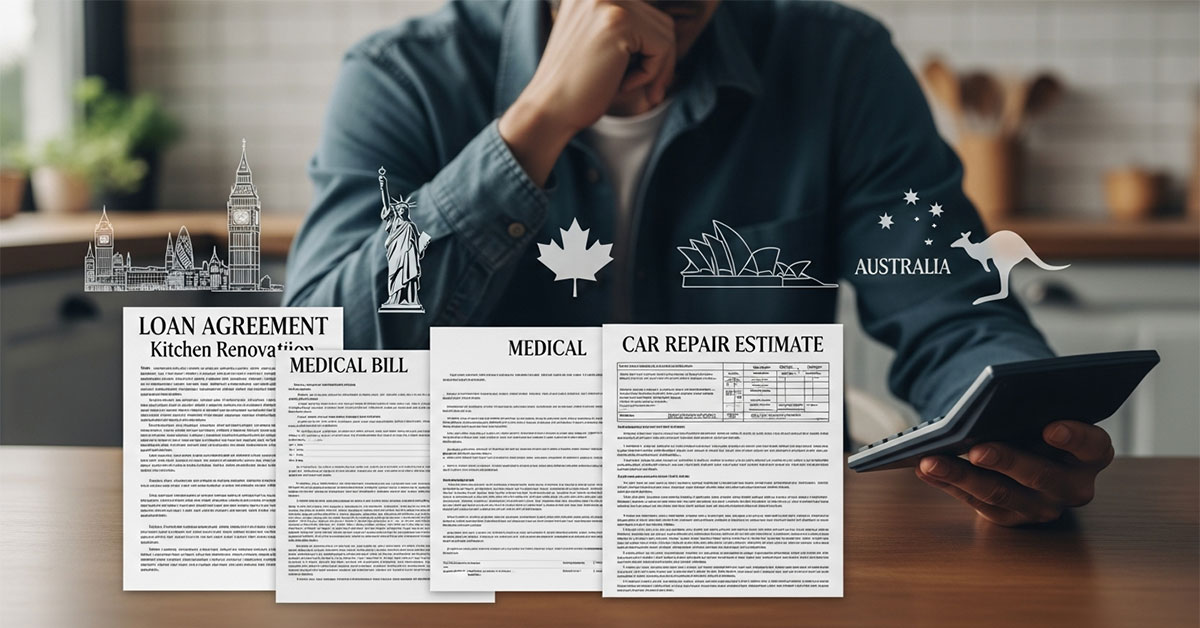Compare personal loans without origination fees with trusted credit union options. No hidden charges, flexible terms, and low rates across US, UK, Canada & Australia.
When you’re approved for a personal loan, receiving the final offer can be a huge relief and—especially if it’s higher than you expected—something of a surprise. You had applied for a loan of $20,000, but the lender will deposit just $19,000 into your account. Where did that $1,000 go? This common thorn is known as an origination fee, a “processing” or “application” charge that lenders impose before you receive the first dime of your loan amount. It’s a hidden cost that quickly raises the real price of your borrowing.
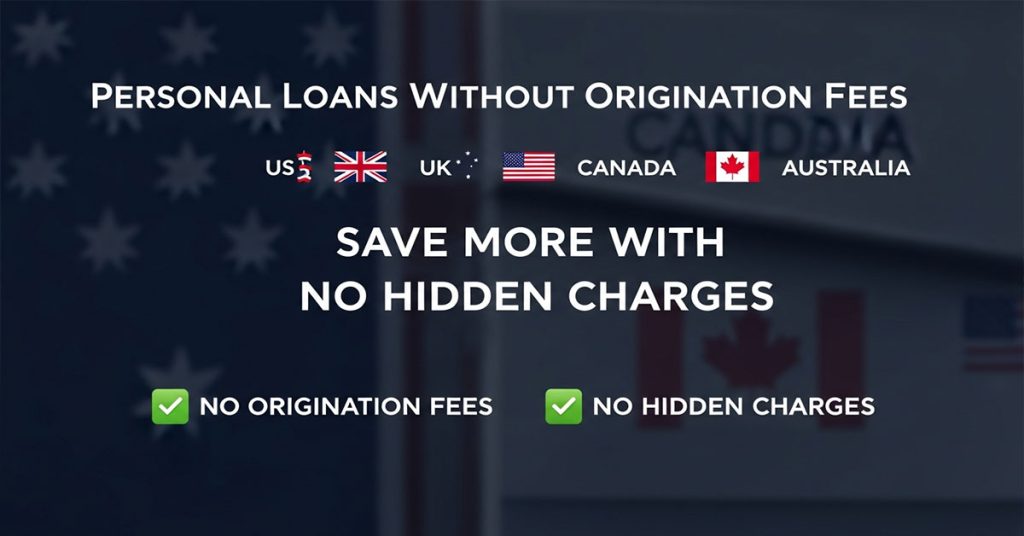
The good news? We are witnessing a new standard of lending. No-fee personal loans are now almost the standard in the personal lending space—particularly at online competitive banks as well as traditional banks, particularly those with a strong presence in Tier One markets such as the U.S., United Kingdom, Canada, and Australia. Here are looser guidelines around the borrowing option—which generally delivers on promises of transparency and savings. When you’re approved for $20,000, you receive the entire $20,000.
This guide is all you need to find your way in the world of no-fee loans. We’ll dive into the leading lenders in the US, UK, Canada, and Australia, demystify the various eligibility criteria, and compare offer options. When you choose a personal loan with no fees, you receive as much money in your pocket as possible and easily open the door to new financial opportunities without having to pay extra just to get started.
Bank Personal Loans With No Origination Fee: Unlock Financial Freedom Without Extra Costs in the US and UK
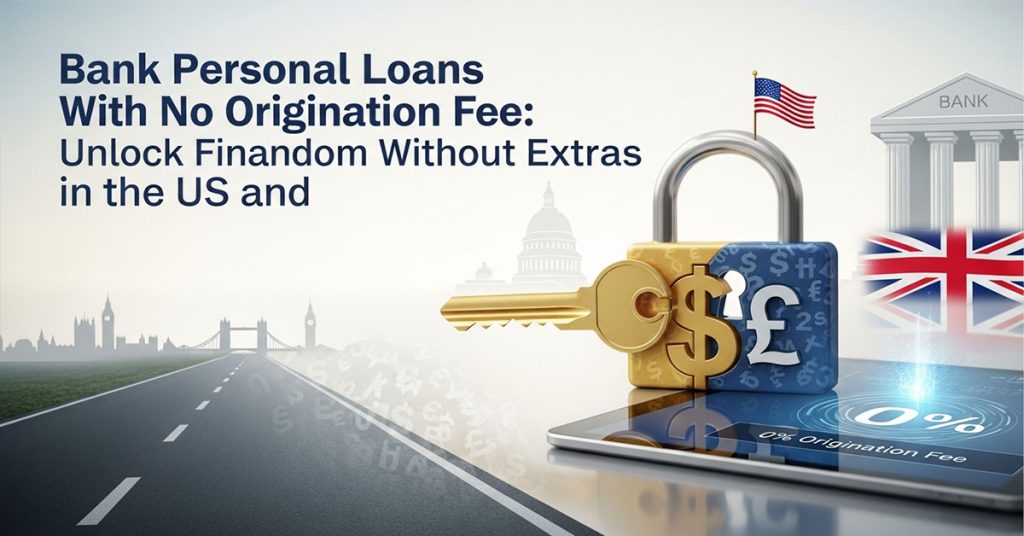
- Traditional banks have been synonymous with personal loans for decades. The game has changed with online fintechs upending the space; however, many incumbent banks in the US and UK have followed suit to compete (particularly for their existing customers) by removing origination fees. These no-fee bank loans provide a potent blend of low costs and the safety of dealing with one of the financial titans.
- Personal loans free of origination fees are available from many large national banks (as an example, Citibank and PNC) as well as community banks in the United States. The most immediate of them is the strength in a pre-existing relationship. What’s more, if you have a checking or savings account there, your steady money movement and financial history are readily apparent to the bank. This often results in:
- Loyalty Rate Discounts: Banks may offer a lower interest rate to current customers.
· Easier Application: They already have most of your personal information, streamlining the process.
· Higher Trust: You are borrowing from the same institution you trust with your daily banking.
In the United Kingdom, the “high-street banks” (such as HSBC, Santander, and Barclays) are major players. The UK market is highly competitive, and “no processing fee” is a standard feature for many of their unsecured personal loan products. The Financial Conduct Authority (FCA) enforces strong transparency rules, so borrowers can easily compare the Annual Percentage Rate (APR), which must, by law, include all mandatory fees. If a loan has no origination fee, its advertised interest rate and its APR will be very close, making comparisons simple.
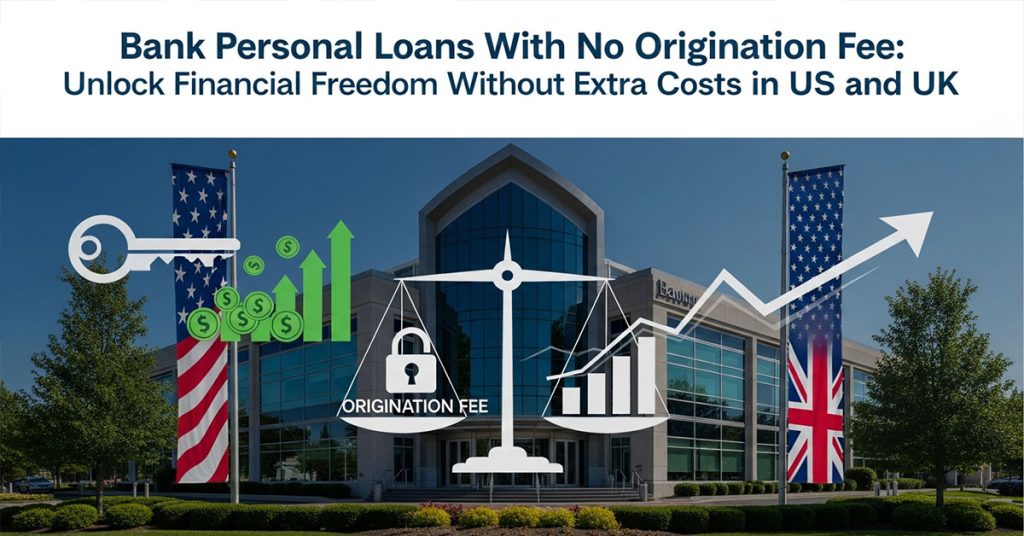
Case Study: Maria’s Home Renovation in New York
Maria, a long-time customer at a major US bank, needed $30,000 for a kitchen remodel. She first checked an online lender, which offered her a 7% interest rate but came with a 5% origination fee. This meant $1,500 would be deducted, and she would only receive $28,500—not enough for her contractor’s deposit.
She then applied with her own bank. Because of her excellent credit and 10-year history as a customer, they offered her a personal loan at 8% with zero origination fees.
| Feature | Online Lender (With Fee) | Maria’s Bank (No Fee) |
| Loan Amount | $30,000 | $30,000 |
| Origination Fee | 5% ($1,500) | $0 |
| Funds Received | $28,500 | $30,000 |
| Interest Rate | 7.0% | 8.0% |
| Total Repaid (5 Yrs) | ~$35,700 | ~$36,500 |
Result: Although the bank’s interest rate was slightly higher, Maria chose her bank. The no-fee loan gave her the full $30,000 she needed for her project today. The “cheaper” 7% loan was useless because it didn’t meet her funding goal after the fee.
For borrowers in the US and UK, your first stop should often be the bank you already use. You may be surprised by the competitive, transparent, and fee-free options they provide.
Key Takeaway: Don’t assume online lenders are always cheaper. For US and UK borrowers with good credit, traditional banks offer strong, no-fee personal loans with the added benefit of an existing relationship.
Online Lenders Offering No Origination Fee Personal Loans: Compare Top Choices for Canadians and Australians
Fintech has been a huge win for borrowers, and that’s better demonstrated nowhere more clearly than in the fierce competition between online lending platforms in Canada and Australia. The fintech companies that have built their business around speed, convenience, and transparency have used “no origination fees” as a main weapon against traditional banks. These platforms provide a quick, easy, and cost-effective way for tech-savvy borrowers to find funding.

In Canada, this includes the “Big Five” banks (RBC, TD, Scotiabank, BMO, CIBC) + a growing crop of digital-only banks and fintech lenders. Here’s what Canadians interested in a no-fee personal loan should consider:
· Digital Banks: You’ll often find places like Tangerine (owned by Scotiabank), or Simplii Financial (which is owned by CIBC), lead with fee-free, hassle-free products like personal loans and lines of credit.
· Fintech Lenders: The gap has been filled by firms offering fast, online-only loan applications. Though some lenders do charge origination fees (also sometimes called “administration fees”), the best ones waive those for borrowers with good credit.
· Credit Unions: Canadian-based credit unions are a great, member-owned option that will almost always have no-fee loan products.
Australia’s consumer protection laws actually have the literal idea of a no-fee loan built into them via the “comparison rate.” Under Australian law, all lenders must display a comparison rate alongside the headline interest rate. This rate includes most fees (such as origination/application fees) to demonstrate the actual cost of the loan. This makes it unbelievably easy to shop for a no-fee loan: If the comparison rate and interest rate are equal, you’re probably looking at a loan with no origination fee.
The “Big Four” (Commonwealth Bank, Westpac, AANZNZ, and NAB) control the Australian market with online no-fee personal loan application services available from all. They’re also competing with the emerging wave of specialist online lenders (think Plenti, NOW Finance, and others), which also have fast approval and transparent, fee-free structures.
Case Study: Liam’s Debt Consolidation in Sydney
Liam, a graphic designer in Sydney, had $25,000 AUD in credit card debt across two cards. He decided to consolidate this into a single personal loan. He found two online offers:
1. Lender A: Advertised a 7.5% interest rate, but had a $500 application fee. Its legally-required comparison rate was 8.3%.
2. Lender B: Advertised an 8.0% interest rate with no application fee. Its comparison rate was 8.0%.
| Feature | Lender A (With Fee) | Lender B (No Fee) |
| Headline Rate | 7.5% | 8.0% |
| Application Fee | $500 | $0 |
| Comparison Rate | 8.3% (True Cost) | 8.0% (True Cost) |
| Total Cost (4 Yrs) | ~$29,450 | ~$29,220 |

Result: Thanks to Australia’s comparison rate system, Liam could immediately see that Lender B was the cheaper and simpler option, even though its headline interest rate looked higher. He applied online and was approved for the full $25,000, which he used to pay off his cards, simplifying his finances and saving him money.
Key Tip for Canadians and Australians: Don’t just look at the interest rate. In Canada, ask for the “total cost of borrowing.” In Australia, always use the comparison rate as your primary tool for finding the cheapest loan.
Discover Personal Loans Without Origination Fees: How to Secure Low-Cost Loans in Tier One Countries
Discover Personal Loans is one of the most popular lenders among US borrowers seeking a no-fee loan. Discover has made a name by focusing on customers and keeping its products clear, uncomplicated, and easy to understand. That “no-fee” commitment isn’t a convenient advertising catchphrase; it’s a fundamental part of their loan philosophy, and helps make them one of the nation’s most competitive low-cost lenders.
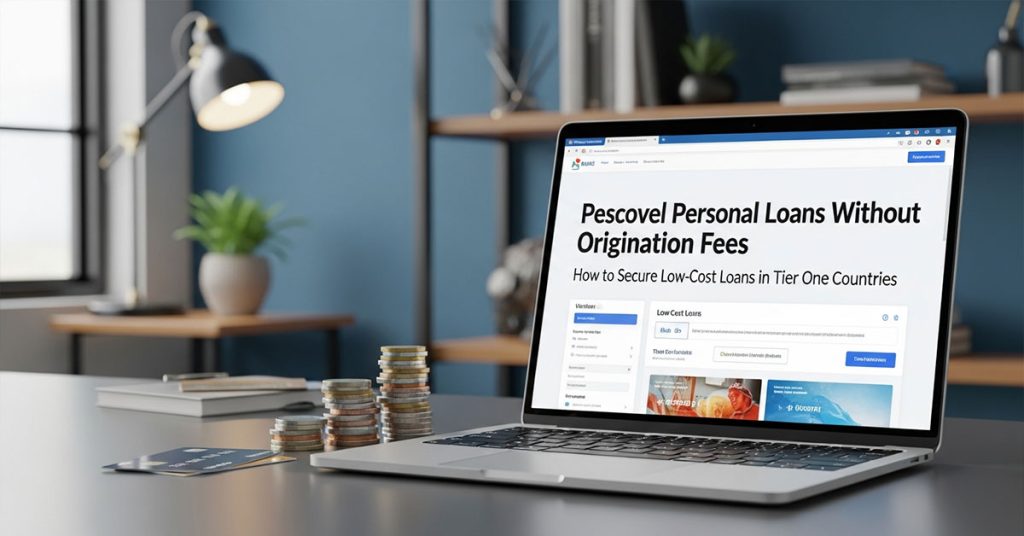
A Discover personal loan is an unsecured, fixed-rate loan; your interest rate and monthly payments will never change. They are typically used for debt consolidation and home improvements, as well as major one-time expenses.
Discover Personal Loans Features:
· No Origination Fees: This is the marketable pro. If you are approved for $35,000, that is what you receive.
· No Prepayment Penalty: Whether in part or in full, you can pay off your loan at any time without penalty. This is an important feature for anyone looking to pay off their debt quickly.
· Fixed Rates: It locks your interest rate for the life of the loan, allowing you to have predictable budgeting.
· Loan Amounts and Terms Vary: Their loans range in size from $2,500 to $40,000 and can be paid over 36 months or as long as 84 months (from 3 to 7 years).
· Quick Funding: Funds are frequently deposited into your bank account as soon as the next business day after approval.
Although Discover is a US-centric lender, the thing for borrowers in the UK, Canada, and Australia to aim for is replicating their model.
When shopping, you are looking for a lender that promises:
1. $0 origination/application/processing fees.
2. $0 prepayment penalties.
3. A fixed APR.
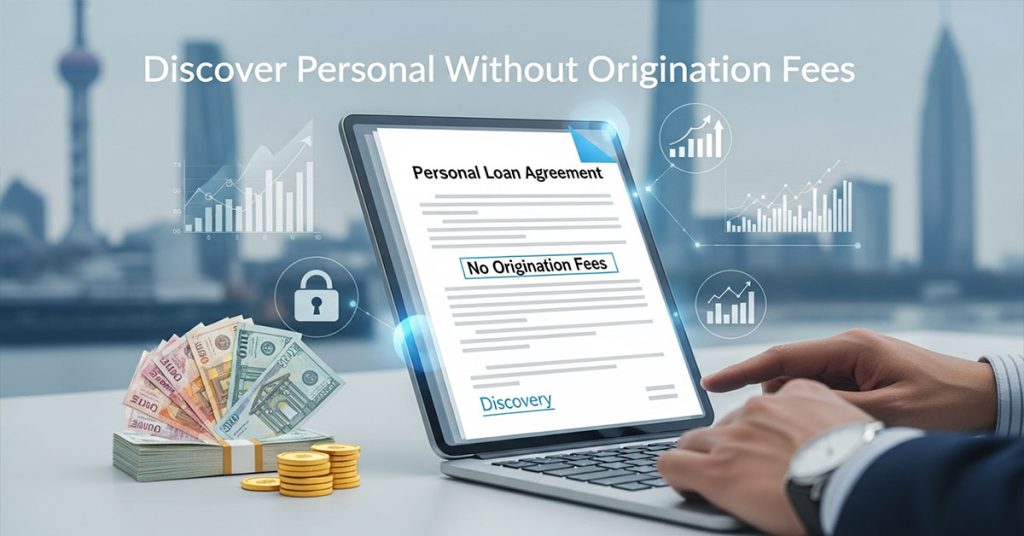
Case Study: Ben and Chloe’s Wedding Fund in Ohio
Ben and Chloe were planning their wedding and needed $20,000 to cover the venue and catering deposits. They had excellent credit (760 FICO) and wanted the process to be as simple as possible.
They pre-qualified with two lenders.
· Lender A offered a 9% rate with a 4% origination fee ($800).
· Discover Personal Loans offered a 10.5% rate with $0 origination fee.
They built a comparison table to see the true cost over a 3-year term:
| Feature | Lender A (With Fee) | Discover (No Fee) |
| Loan Amount | $20,000 | $20,000 |
| Origination Fee | $800 (4%) | $0 |
| Funds Received | $19,200 | $20,000 |
| APR | ~11.8% | 10.5% |
| Monthly Payment | $636 | $650 |
| Total Repayment | ~$22,900 | ~$23,400 |
Result: This case is tricky! And the Discover loan had barely more repayment overall. But Ben and Chloe opted for Discover. Why? Because they only received $19,200 from Lender A, which did not cover their $20,000 in deposits. To get the additional $20,000 they needed from Lender A, they would have had to apply for about ~$20,830, which is more math and a larger loan.
They went with Discover because of its transparency and no fuss. They asked for $20,000, received $20,000 the next day, and knew exactly how much they’d be paid. The “no-fee” promise proved to be precisely the right financing, just when they needed it.
Key Takeaway: The “best” loan isn’t just the one with the lowest total cost. It’s the one that delivers the exact amount of money you need with the most transparent terms. Discover excels at this for US borrowers.
SoFi Personal Loans: No Fees, No Worries – Perfect for US Borrowers
In the world of US fintech, SoFi (Social Finance, Inc.) stands out as a leader, particularly for high-income earners and borrowers with strong credit. SoFi built its brand on a simple, powerful promise: “No fees. Period.” This applies to their personal loans, student loan refinancing, and mortgages. For US borrowers looking for a personal loan without origination fees, SoFi is often the gold standard.
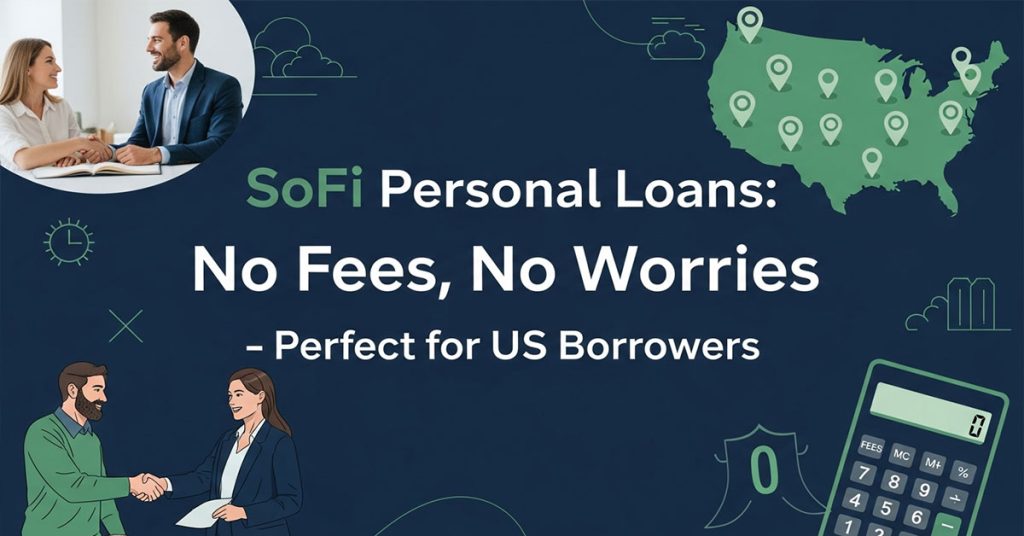
SoFi’s model is geared toward a specific “prime” borrower: someone with a high credit score (typically 700+), strong income, and a healthy DTI (debt-to-income) ratio. In exchange for this low risk, SoFi provides an exceptional loan product.
Key Features of SoFi Personal Loans:
· Absolutely No Fees: This is their core commitment. No origination fees, no prepayment penalties, and (a key differentiator) no late fees.
· High Loan Amounts: SoFi is built for big goals, offering unsecured personal loans from $5,000 up to $100,000.
· Competitive Rates: Because they are selective about their borrowers, they can offer some of the most competitive fixed APRs on the market.
· Member Benefits: This is SoFi’s unique value-add. When you take out a loan, you become a “member,” which unlocks free access to financial planners, career coaching, unemployment protection, and member-only events.
· Autopay Discount: They offer a 0.25% interest rate discount for setting up automatic payments.
Case Study: Dr. Aisha Khan’s Debt Consolidation
Dr. Aisha Khan, a new dentist in Chicago, had a strong income but was managing $60,000 in high-interest debt from private student loans and credit cards she used during her residency. Her credit score was 740. She needed a large loan to consolidate everything into one simple, low-rate payment.
She applied to SoFi and a traditional bank.
· The Bank offered her a $60,000 loan at 8.5% but with a 3% origination fee ($1,800). She would only receive $58,200.
· SoFi approved her for the full $60,000 at 8.99% (which dropped to 8.74% with the Autopay discount) and zero fees.
| Feature | Traditional Bank (With Fee) | SoFi (No Fee) |
| Loan Amount | $60,000 | $60,000 |
| Origination Fee | $1,800 (3%) | $0 |
| Funds Received | $58,200 | $60,000 |
| APR | ~9.6% | 8.74% |
| Monthly Payment (7 Yrs) | $908 | $903 |
| Total Repayment | ~$76,270 | ~$75,850 |
Result: On every measure, SoFi was the winner. Dr. Khan got her entire $60,000 to cover all of her debts. Her APR was lower, her monthly payment was lower, and her repayment cost in dollars was lower. The $1,800 she saved on the origination fee provided an immediate, concrete benefit. She also got access to SoFi’s financial planning services, which helped her manage the new (higher) income.
US borrowers with good-to-excellent credit and stable income who want a no-fee personal loan have at their disposal one of the most competitive products in the market with SoFi.
Key Takeaway: SoFi proves that “no fees” doesn’t have to mean higher rates. For their target audience (high-credit, high-income), they offer a truly low-cost loan and throw in valuable member perks.
Marcus by Goldman Sachs: No Origination Fee Personal Loans for UK and Canadian Borrowers
When Goldman Sachs, one of the world’s most recognizable investment banks, decided to enter the consumer lending space, it did so with a powerful, simple product: Marcus by Goldman Sachs. The Marcus platform was designed from the ground up to be digital-first, transparent, and fee-free, directly challenging both traditional banks and new fintechs.
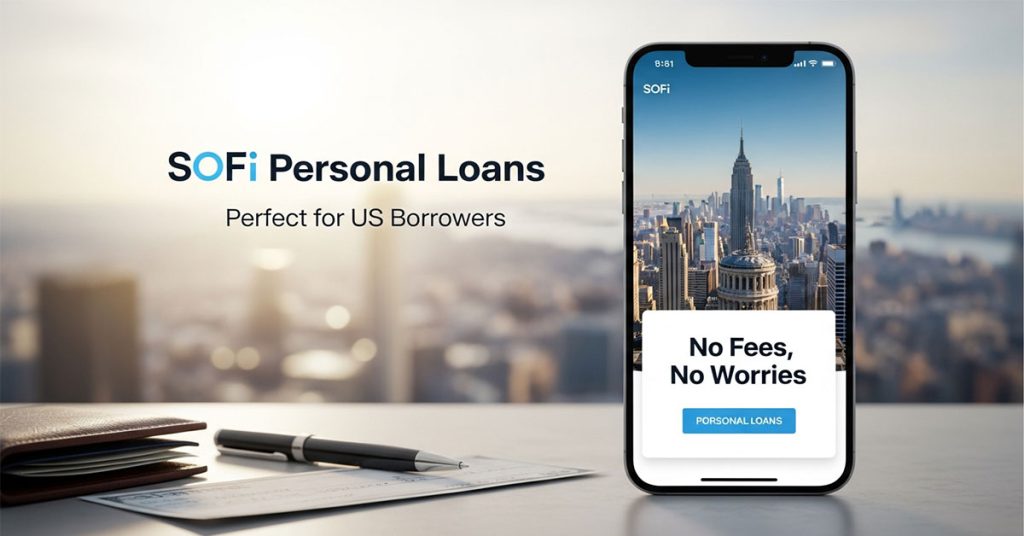
While Marcus has a major presence in the US, it has also become a significant player in the United Kingdom. For UK borrowers, Marcus quickly became a favorite for its “no-fee, no-fuss” approach to personal loans and online savings.
Key Features of Marcus UK:
· No Origination Fees: A core promise of the Marcus brand.
· No Prepayment Penalties: You can make extra payments or pay off your loan early at any time, saving you interest.
· Fixed Rates: The rate is locked in, so your payments are predictable.
· On-Demand Payment Feature: A unique perk allowing borrowers to skip a payment (with interest still accruing) after making 12 consecutive on-time payments, offering flexibility.
What about Canada?
The prompt asks about Canadian borrowers, but Marcus does not offer personal loans in Canada. This is a critical distinction.
However, the spirit of the Marcus model is very much alive in Canada. Canadian borrowers looking for a “Marcus-like” experience (digital, transparent, no-fee) should look to:
1. Canada’s Digital Banks: As mentioned earlier, banks like Tangerine and Simplii Financial are the closest equivalents. They operate online, have low overhead, and pass those savings to customers with no-fee checking, high-interest savings, and competitive, no-fee loans and lines of credit.
2. Major Bank Online Platforms: Canada’s “Big Five” banks (RBC, TD, etc.) all have robust online platforms that offer no-fee personal loans to qualified applicants.
3. Credit Unions: Canadian credit unions (like Vancity or Meridian) are member-owned and champion a “people-first” model, which almost always includes no-fee loan products.
Case Study: Nigel (UK) and Sophie (Canada)
Nigel in London, UK: Nigel needed $\pounds$10,000 for a new, energy-efficient boiler. He applied for a Marcus personal loan. He was approved at a 6.5% fixed APR. He received the full $\pounds$10,000 in his bank account two days later. There were no hidden charges, and his monthly payment was clear. He felt in control and valued the transparency.
Sophie in Toronto, Canada: Sophie also needed $10,000 CAD for home repairs. She couldn’t apply for a Marcus loan, so she looked for Canadian alternatives.
· Fintech Lender: Offered 8% + a 2% “administration fee” ($200).
· Tangerine (Digital Bank): Offered a 9.5% fixed-rate loan with $0 fees.
| Feature | Sophie’s UK Equivalent (Marcus) | Canadian Fintech | Canadian Digital Bank (Tangerine) |
| Loan Amount | $\pounds$10,000 | $10,000 CAD | $10,000 CAD |
| Origination Fee | $\pounds$0 | $200 CAD (2%) | $0 CAD |
| Funds Received | $\pounds$10,000 | $9,800 CAD | $10,000 CAD |
| APR | 6.5% | ~9.1% | 9.5% |
Result: Sophie, like Ben and Chloe in the US, faced a choice. The fintech loan (after the fee) was actually cheaper over the life of the loan. However, she needed the full $10,000 for her contractor. She chose the no-fee Tangerine loan because it was transparent and provided the exact funds she required.
Key Takeaway for UK/Canadian Borrowers: UK borrowers can directly benefit from Marcus’s no-fee model. Canadian borrowers can find the same value by looking at digital-first banks (like Tangerine) and local credit unions, which champion the same transparent, no-fee philosophy.
How to Apply for a Personal Loan Without an Origination Fee: A Step-by-Step Guide for US, UK, and Australian Applicants
Securing a personal loan with no origination fee is straightforward if you know where to look and how to prepare. These loans are typically reserved for borrowers with good-to-excellent credit, so the application process is all about demonstrating your financial stability and creditworthiness.
Here is a step-by-step guide for applicants in the US, UK, and Australia.
Step 1: Check Your Credit Score and Report
Before you apply, you must know where you stand. Lenders will use your credit history to determine your eligibility and interest rate.
· United States: Check your FICO Score. Many credit cards and banks offer this for free. A score of 690+ is generally needed for a no-fee loan, with 720+ securing the best rates.
· United Kingdom: Check your credit file with all three main agencies (Experian, Equifax, TransUnion). Lenders in the UK review your full report, not just a single score. A long history of on-time payments is key.
· Australia: Get your credit score (a number between 0 and 1000 or 0 and 1200, depending on the agency). A score of 700+ (“Good” or “Very Good”) is the typical starting point.
Step 2: Shop Around and Prequalify (The “Soft Pull”)
This is the most important step. Never do a full application for a loan just to “see the rate.” Instead, use the “Check Your Rate” or “Prequalify” tools offered by lenders like SoFi, Marcus, Discover, and major banks.
This process uses a soft credit inquiry, which does not affect your credit score. You can prequalify with 5-6 different lenders in one afternoon to see your real, personalized interest rate and loan offers. This allows you to comparison shop risk-free.
Step 3: Gather Your Documentation
Once you’ve chosen the best offer, you’ll need to formally apply. Lenders need to verify your identity, address, and income. Have these documents ready (scanned or as PDFs):
· US: Social Security number (SSN), driver’s license or state ID, recent pay stubs, W-2s or tax returns (if self-employed), bank statements.
· UK: Proof of address (utility bill, council tax bill), passport or driver’s licence, recent bank statements, payslips.
· Australia: 100 points of ID (e.g., driver’s licence, passport, Medicare card), proof of income (payslips, bank statements), details of your assets and liabilities.
Step 4: Compare the True Cost of Your Offers
You have three offers. How do you pick? Look at the official Loan Agreement or “offer disclosure.”
· US/UK: Compare the APR (Annual Percentage Rate). This number includes the interest rate plus any mandatory fees (which should be $0 for a no-fee loan). The lowest APR is the cheapest loan.
· Australia: Compare the Comparison Rate. This is the Australian equivalent of APR and is legally required. It’s your single best tool for comparing loan costs.
Case Study: Jack’s Strategic Application in Melbourne
Jack from Melbourne wanted a $30,000 AUD loan.
1. Credit Check: He checked his score and found it was 810 (“Excellent”).
2. Prequalify: He used comparison sites to get pre-approved offers from his bank (NAB) and two online lenders (Plenti, NOW Finance).
3. Documentation: He gathered his driver’s licence and payslips.
4. Compare:
o NAB: 8.5% interest, $0 fee. Comparison Rate: 8.5%.
o Lender 2: 7.9% interest, $450 fee. Comparison Rate: 8.7%.
o Lender 3: 8.2% interest, $0 fee. Comparison Rate: 8.2%.
Result: Jack confidently chose Lender 3. It was the cheapest true-cost loan, and the application was simple.
Application Checklist (US vs. UK vs. AU)
| Requirement | United States | United Kingdom | Australia |
| Credit Check | FICO Score (target 690+) | Credit File (Experian, etc.) | Credit Score (target 700+) |
| Key ID | Social Security Number | Proof of Address (e.g., utility bill) | 100 Points of ID |
| Income Proof | Pay stubs, W-2s | Payslips, Bank Statements | Payslips, Tax Returns |
| Cost Metric | APR | APR | Comparison Rate |
Key Takeaway: The “soft pull” prequalification step is your best friend. It allows you to shop for the best rate in the US, UK, and Australia without any negative impact on your credit score.
Loan Amounts and Terms: How Much Can You Borrow Without Paying Origination Fees?
When lenders forgo origination fees, they are effectively signaling trust in the borrower. These loans are typically available to “prime” (good-to-excellent-credit) applicants, so the amounts are usually significant. It’s not just small amounts you can apply for; no-fee loans in the US go up to $100,000.
Typical Loan Amounts:
· United States: This market has the widest range. Lenders like SoFi and LightStream offer no-fee loans up to $100,000. More common amounts from lenders like Discover and Marcus range from $2,500 to $50,000.
· United Kingdom: Loan amounts are generally more modest. High-street banks and lenders like Marcus UK typically offer unsecured loans up to $\pounds$25,000 or $\pounds$30,000.
· Canada & Australia: The range is similar to the UK. Major banks and online lenders typically offer no-fee unsecured loans up to $30,000 – $50,000.
Typical Loan Terms (Repayment Period):
The term is how long you have to repay the loan.
· Pros of a Longer Term: Your monthly payment will be lower and more manageable.
· Cons of a Longer Term: You will pay significantly more in total interest over the life of the loan.
Most lenders offer terms from 2 to 7 years (24 to 84 months). Lenders in the US are more likely to offer 6- or 7-year terms, while 5-year terms are more of a standard maximum in the UK and Australia.
Expert Insight: “Choose the shortest loan term you can comfortably afford. A $20,000 loan at 8% for 3 years costs $2,540 in interest. The exact same loan over 7 years costs $6,200 in interest. Since no-fee loans almost never have prepayment penalties, you can choose a 5-year term for the manageable payment, but make extra payments to kill the debt in 3 years and save thousands.”
Interest Rates and Fees: What to Expect When You Choose No Origination Fee Personal Loans
This is the most critical trade-off to understand. How can a lender give you a “no-fee” loan? They make their money in one of two ways:
1. From the Interest Rate: The lender may charge a slightly higher interest rate on its no-fee loan than a competitor charges on a loan with a fee.
2. From Low-Risk Borrowers: They only offer no-fee loans to borrowers with great credit who are very unlikely to default. Their business model is built on low risk, not on fee income.
Your goal is to find the loan with the lowest total cost. This is where the APR (Annual Percentage Rate) comes in.
· Interest Rate: The “headline” rate used to calculate your monthly interest.
· APR (US/UK) / Comparison Rate (AU): The true cost of the loan. It includes the interest rate plus all mandatory fees, expressed as an annual percentage.
With a no-origination-fee loan, the Interest Rate and the APR will be almost identical.
Cost Comparison: Fee vs. No-Fee Loan
Let’s imagine you need a $15,000 loan over 3 years.
| Feature | Lender A (With Fee) | Lender B (No Fee) |
| :— | :— | :— |
| Interest Rate | 7.0% (Looks Cheaper) | 8.5% |
| Origination Fee | 4% ($600) | $0 |
| Funds Received | $14,400 | $15,000 |
| APR | ~9.8% (True Cost) | 8.5% (True Cost) |
| Monthly Payment | $463 | $473 |
| Total Repayment | $16,668 | $17,028 |
Analysis: This is a complex case. Lender A has a lower monthly payment, but you only get $14,400. Lender B gives you the full $15,000. But the most important number is the APR. Lender B’s 8.5% APR is the clear winner over Lender A’s 9.8% APR. Lender B is the cheaper, more transparent loan.
Expert Insight: “Always, always, always compare the APR (US/UK) or the Comparison Rate (AU). These figures are legally required to exist for one reason: to cut through the marketing and show you the true, total cost of borrowing. A low headline interest rate with a high fee is often a financial trap.”
Eligibility Requirements for No Origination Fee Loans: Make Sure You’re Approved in Tier One Markets
No-origination-fee loans are a premium product. Lenders waive the fee because they are confident the borrower will pay the loan back in full. This means that, in general, eligibility requirements are stricter than for loans that charge fees.
If your credit is “fair” or “poor,” it will be very difficult to find a no-fee personal loan. Lenders use fees to offset the higher risk of default from subprime borrowers.
Here are the typical requirements in Tier One markets:
1. Good to Excellent Credit Score: This is the most important factor.
o US: A FICO score of 690+, with the best rates reserved for 720+.
o UK: A “Good” or “Excellent” credit file with a strong history of on-time payments.
o Canada: A credit score of 660+, but more likely 700+ for the best no-fee offers.
o Australia: A credit score of 700+ (“Good” or “Very Good”).
2. Stable, Verifiable Income: You must prove you have a job and a consistent income that can easily support the new monthly loan payment. Lenders will verify this with payslips, bank statements, or tax returns.
3. Low Debt-to-Income (DTI) Ratio: This is especially critical in the US. Your DTI is your total monthly debt payments divided by your gross monthly income. Lenders want to see a DTI below 43%, and preferably below 36%, including the new loan payment.
4. Residency Status: You must be a legal resident of the country you are borrowing in (e.g., US citizen, permanent resident, or specific visa holder; UK resident; etc.).
| Requirement | Ideal Target (for No-Fee Loans) |
| Credit Score (US) | FICO 720+ |
| Credit Score (AU/CA) | 700+ |
| Credit History (UK) | “Good” or “Excellent” |
| Debt-to-Income (DTI) | Below 40% (preferably below 36%) |
| Employment | Stable, verifiable income |
Expert Insight: “If your credit score is just below these thresholds, don’t apply yet. Spend 3-6 months improving it. The single best way is to pay down your credit card balances. Lowering your ‘credit utilization’ (the amount you owe vs. your limit) can boost your score 30-50 points in a few months, potentially saving you thousands in interest and opening the door to these high-quality, no-fee loans.”
Benefits of Choosing a No Origination Fee Loan: Maximize Your Savings with No Hidden Charges
The advantages of a no-fee loan go beyond just saving money on one charge. They create a simpler, more transparent, and more flexible borrowing experience.
1. You Get Your Full Loan Amount: This is the clearest benefit. If you need $25,000 for a home improvement project, you get the full $25,000. With a 5% loan fee, you’d only get $23,750, leaving you short. A no-fee loan ensures your funding goal is met precisely.
2. Transparent and Simple Comparisons: When there are no fees, the APR and the interest rate are the same. This makes comparison shopping incredibly easy. You just need to find the lender offering the lowest APR. There is no complex math to figure out the “true cost.”
3. Lower Total Cost of Borrowing (Usually): For borrowers with good credit, a no-fee loan is almost always cheaper. A 1% or 2% difference in interest rate is often far less costly than a 5% or 6% upfront fee.
4. Financial Flexibility: Lenders who offer no-fee loans (like SoFi, Marcus, and Discover) almost always offer no prepayment penalties as well. This gives you control. You can pay off the loan ahead of schedule—with a work bonus or by making bi-weekly payments—and save a significant amount on interest.
Savings Example: The Real-World Impact
Imagine you need $20,000.
| Feature | Loan A (With 5% Fee) | Loan B (No Fee) |
| :— | :— | :— |
| Amount Borrowed | $20,000 | $20,000 |
| Fee | $1,000 | $0 |
| Cash in Your Pocket | $19,000 | $20,000 |
| Immediate Savings | $0 | $1,000 |
Expert Insight: “The psychological benefit of a no-fee loan is immense. It builds trust. The lender is signaling, ‘We are not here to trick you with hidden charges.’ This non-adversarial relationship is a healthier way to borrow and is a cornerstone of the business model for modern fintechs like SoFi and Marcus.”
Potential Drawbacks to Consider: What to Watch Out for When Applying for No-Fee Personal Loans
While “no fees” sounds perfect, there are trade-offs and potential pitfalls to be aware of. These loans are not the best choice for every borrower in every situation.
1. Higher Interest Rates: This is the most common trade-off. A lender might offer you two choices: a 7% interest rate + 5% fee, OR a 9% interest rate + $0 fee. The lender needs to make a profit. They may “bake” the cost of the fee into the interest rate. You must compare the APRs to see which is truly cheaper.
2. Stricter Eligibility Requirements: As covered in the H3 above, this is the biggest hurdle. No-fee loans are an exclusive product for low-risk borrowers. If you have fair credit (e.g., a 640 FICO score in the US), you will likely not qualify and will have to opt for a fee-based loan from a lender that serves that market.
3. Risk of Other Fees: “No origination fee” does not mean “no fees at all.” Always read the fine print of your loan agreement for other potential charges:
o Late Fees: Most lenders charge these (SoFi is a notable exception).
o Prepayment Penalties: Rare for no-fee unsecured loans, but always double-check.
o Check Processing Fees: Some lenders charge a fee if you don’t use autopay and mail a physical check.
| Drawback | What to Watch For |
| Higher Interest Rate | Always compare the APR or Comparison Rate, not the headline rate. |
| Strict Eligibility | You likely need a 690+ FICO (US) or “Good” credit (UK/AU/CA). |
| Other “Hidden” Fees | Read the loan agreement and confirm there are no prepayment penalties or late fees. |
Expert Insight: “Don’t assume ‘no-fee’ is always cheapest. I’ve seen cases where a borrower with ‘fair’ credit was better off taking a 10% rate with a 3% fee from a credit union than a 16% rate with no fee from an online lender. The only thing that matters is the total cost of repayment. Do the math every single time.”
Tips for Securing the Best No-Fee Personal Loan: How to Get the Most Value in the US, UK, and Canada
You’ve built good credit. Now it’s time to leverage it to get the best possible deal. Securing a no-fee loan is good; securing one with the lowest possible interest rate is even better.
1. Boost Your Credit Score (Even Higher): If your score is 720 (US), can you get it to 760? The single fastest way is to pay down your credit card balances to below 10% of your credit limits. This “credit utilization” trick can boost your score significantly in just 1-2 months, right before you apply.
2. Prequalify with Multiple Lender Types: Don’t just check online lenders. Get prequalified rates from:
o Top Online Lenders (e.g., SoFi, Marcus, Discover in the US).
o Your Primary Bank (e.g., Chase, PNC in the US; HSBC, Barclays in the UK; RBC, TD in Canada).
o A Local Credit Union (These member-owned institutions, especially in the US and Canada, are famous for low rates and no fees).
3. Set Up Autopay: This is an instant win. Many lenders (especially SoFi and other US fintechs) offer a 0.25% to 0.50% interest rate discount just for setting up automatic payments from your checking account. This is a free way to save hundreds of dollars.
4. Choose the Shortest Term You Can Afford: Lenders offer lower interest rates for shorter-term loans. A 3-year loan will almost always have a lower APR than a 7-year loan because the lender’s risk is lower.
| Action | Impact |
| Lower Credit Card Balances | Boosts credit score $\rightarrow$ Lowers your offered rate. |
| Compare 3+ Lenders | Creates competition, ensures you find the best offer. |
| Sign Up for Autopay | Often gives an instant 0.25% rate discount. |
| Select a Shorter Term | Lenders offer lower APRs for shorter loans (e.g., 3 vs. 5 years). |
Expert Insight: “In the UK and Canada, your relationship with your primary bank is a powerful asset. Go to them with a prequalified offer from an online lender and ask, ‘Can you beat this?’ Often, they will waive fees or offer a rate discount to keep a high-quality customer. You have the leverage—use it.”
Understanding the Fine Print of Loan Offers: What You Need to Know About No Origination Fees in the US and UK
You’ve found a great “no-fee” offer. Before you sign, it’s time to put on your glasses and read the loan agreement. The “fine print” is where a lender’s promises are made legally binding.
In the US, look for the Truth in Lending Act (TILA) Disclosure, often called the “TILA Box.” This is a standardized box that legally requires the lender to clearly state:
1. APR: The true annual cost.
2. Finance Charge: The total dollar amount of interest and fees you’ll pay.
3. Amount Financed: The amount of money you are actually receiving. (This should equal your loan amount if there is no fee.)
4. Total of Payments: The full amount you will have paid back by the end of the loan.
In the UK, the Financial Conduct Authority (FCA) requires lenders to provide a “Pre-contract Credit Information” document. This serves the same purpose. It will clearly itemize the APR, the total amount payable, and any and all fees.
Key phrases to search for (Ctrl+F):
· “Origination Fee”
· “Processing Fee”
· “Administration Fee” (common in Canada)
· “Application Fee”
· “Prepayment Penalty”
· “Early Closure Fee”
Key Takeaway: The “Amount Financed” is your key. If you are borrowing $25,000, and the “Amount Financed” says $25,000, you have a true no-origination-fee loan.
Explore more details here $\rightarrow$ Learn how to read a TILA loan disclosure box (US).
Comparing Lenders to Find the Best Deal: How to Choose the Right Loan with No Origination Fee
You’ve prequalified with three no-fee lenders. All are offering you a $20,000 loan. How do you choose?
· Lender A: 8.5% APR, 5-year term. Monthly Payment: $410. Total Repayment: $24,600.
· Lender B: 9.0% APR, 5-year term. Monthly Payment: $415. Total Repayment: $24,900.
· Lender C: 8.2% APR, 3-year term. Monthly Payment: $628. Total Repayment: $22,608.
How to decide:
1. Affordability: Can you afford Lender C’s $628 payment? If not, it’s off the table, even though it’s the cheapest.
2. Cheapest Cost: If you can afford $628, Lender C is the clear winner. It saves you almost $2,000 compared to Lender A.
3. Comparing Apples-to-Apples: If you can only afford the 5-year term, Lender A is the clear winner over Lender B. Its 8.5% APR is lower, leading to a lower payment and lower total cost.
Your Checklist:
· Compare the APR, not the interest rate.
· Compare the Total Repayment amount.
· Compare the Monthly Payment for affordability.
· Check for a Prepayment Penalty (it should be $0).
· Read lender reviews on sites like Trustpilot or Reddit to check for customer service issues.
Key Takeaway: The “best deal” is a balance. It’s the loan with the lowest total repayment that also has a monthly payment you can comfortably afford.
Why Choosing the Right Lender Matters: How to Avoid Surprises in Your Loan Agreement
A loan is a multi-year relationship. Choosing a lender based only on the lowest APR can be a mistake if that lender has a terrible reputation. The lender you choose impacts your financial life for years.
Avoid these surprises:
· Surprise #1: Terrible Customer Service. You have a payment issue or a question. You call the lender and are stuck in an automated phone-tree nightmare for 45 minutes. Reputable lenders (like Discover, Marcus, SoFi, and major banks) invest heavily in customer support.
· Surprise #2: A Clunky, Outdated App. In 2025, you should be able to manage your loan, check your balance, and make payments from a clean, simple mobile app. A lender with a buggy website is a constant annoyance.
· Surprise #3: Aggressive Collections. If you hit a rough patch (like a job loss) and are a few days late, how does the lender react? Do they call you 10 times a day? Or do they have hardship programs and work with you?
· Surprise #4: Sold Debt. Some lenders originate your loan and then immediately sell it to a third-party debt servicer you’ve never heard of. This can be disorienting. Lenders who “service” their own loans (like Discover, SoFi, and Marcus) provide a more consistent experience.
Key Takeaway: Your loan agreement is a contract. Choosing a reputable, well-reviewed lender ensures the partner on the other side of that contract is fair, accessible, and easy to work with for the next 3-7 years.
How to Evaluate No Fee Personal Loan Offers: A Practical Guide for Borrowers in Tier One Countries
You have your prequalified offers. It’s time to build your “decision table.”
Open a simple spreadsheet (or use a notepad) with these columns. This simple act organizes your thoughts and makes the best choice obvious.
| Feature | Lender A (e.g., SoFi) | Lender B (e.g., Your Bank) | Lender C (e.g., Discover) |
| Loan Amount | $25,000 | $25,000 | $25,000 |
| Origination Fee | $0 | $0 | $0 |
| Term (Months) | 60 | 60 | 60 |
| Interest Rate | 8.99% | 9.25% | 9.50% |
| APR | 8.99% | 9.25% | 9.50% |
| Monthly Payment | $518 | $522 | $525 |
| Total Repayment | $31,080 | $31,320 | $31,500 |
| Prepayment Penalty? | No | No | No |
| Autopay Discount? | Yes (0.25%) | No | No |
| Lender Rating | 4.5 Stars | 4.0 Stars | 4.6 Stars |
Analysis:
1. After its 0.25% autopay discount, Lender A’s (SoFi) real APR would be 8.74%, making it the cheapest loan by a wide margin.
2. All are affordable and have similar monthly payments.
3. All have great lender ratings.
The choice is clear: Lender A is the best offer. This simple evaluation process takes 10 minutes and can save you thousands of dollars.
Explore more details here $\rightarrow$ Download our free, simple loan comparison template.
Steps to Secure the Best Loan Rate: How to Get the Most Competitive Rate Without Origination Fees
You can influence the interest rate you are offered. The rate is not fixed; it’s a direct reflection of the risk you present to the lender. To get the best rate, you must become the best (lowest-risk) applicant.
Before You Apply:
1. Pay Down Credit Card Debt: This is the #1 strategy. Lowering your “credit utilization” (e.g., from 50% of your limit to 10%) can dramatically increase your credit score.
2. Lower Your DTI Ratio: If you have any other small loans (like a “buy now, pay later” plan) that you can pay off, do it. This lowers your DTI ratio, making you look more financially stable.
3. Add a Co-signer (US/Canada): If you have a spouse or family member with excellent credit, adding them as a co-signer (or making it a joint application) can give you access to much lower rates. Warning: This is a huge risk for the co-signer. If you default, they are 100% responsible for the debt.
During Application:
4. Select the Shortest Term You Can Afford: As mentioned before, a 3-year term will always have a lower rate than a 7-year term.
5. Enable Autopay: Always check the box for the 0.25% – 0.50% autopay discount. It’s free money.
Key Takeaway: The rate you get is a direct result of the preparation you do. A single month spent paying down credit cards before you apply can be the difference between a 12% APR offer and a 9% APR offer.
Impact of No Origination Fees on Loan Costs: How It Affects Your Total Repayment in the US and Australia
The impact of a no-origination-fee loan is most powerful on larger loan amounts. A 4% fee on a $5,000 loan is $200. But a 4% fee on a $50,000 loan is $2,000.
Let’s look at a $30,000 loan for debt consolidation over 5 years.
· Loan A (US Lender): 8% interest + 4% origination fee ($1,200).
o You receive: $28,800.
o Your monthly payment (on the full $30k) is $608.
o Your total repayment is $36,480.
o Your true APR is ~9.7%.
· Loan B (US Lender, No Fee): 9.5% interest + $0 fee.
o You receive: $30,000.
o Your monthly payment is $630.
o Your total repayment is $37,800.
o Your true APR is 9.5%.
Result: In this case, Loan B (the no-fee loan) is the clear winner. Its APR is lower (9.5% vs 9.7%), and most importantly, it gives you the full $30,000 you need to pay off your debts. Loan A leaves you $1,200 short.
In Australia, this is even simpler. The law does the math for you.
· Loan A (AU Lender): 8% rate + $1,200 fee $\rightarrow$ Advertised Comparison Rate: 9.7%
· Loan B (AU Lender): 9.5% rate + $0 fee $\rightarrow$ Advertised Comparison Rate: 9.5%
An Australian borrower can see in 5 seconds that Loan B is the cheaper product.
Key Takeaway: The origination fee always makes the APR higher than the interest rate. A no-fee loan is transparent: the APR is the interest rate. This simplicity is one of its greatest strengths.
Key Factors to Consider Before Choosing a Personal Loan: What You Should Know About No Origination Fees
Before you accept any loan offer, run through this final mental checklist.
1. The APR (or Comparison Rate): Is this the lowest true cost I was offered?
2. The Monthly Payment: Can I comfortably afford this payment every month, even if I have an unexpected car repair?
3. The Total Repayment: Am I comfortable with the total amount of interest I’ll be paying?
4. The Loan Term: Is this term appropriate? (e.g., don’t take a 7-year loan for a 2-week vacation).
5. The Fees: Have I confirmed there is a $0 origination fee and a $0 prepayment penalty?
6. The Lender: Is this lender reputable? Have I read reviews?
| Factor | Why It Matters |
| APR | The true, all-in cost. Lowest APR wins. |
| Monthly Payment | Your ability to afford the loan and avoid default. |
| Prepayment Penalty | Must be $0 so you have the flexibility to pay it off early. |
How No Origination Fee Loans Can Save You Money: Real-Life Savings Examples for US and Canadian Borrowers
Let’s make this tangible.
US Example: Sarah in Texas (Debt Consolidation)
· Debt: $30,000 in credit cards at an average 22% APR.
· Her Goal: Consolidate into one loan.
· Offer 1 (Fee-Based): 10% rate + 6% origination fee ($1,800).
· Offer 2 (No-Fee, e.g., SoFi): 11% rate + $0 fee.
· The Math: That $1,800 fee on Offer 1 makes its true APR 12.3%. The no-fee loan’s APR is 11%.
· The Savings: By choosing the no-fee loan, Sarah saves $1,800 instantly by getting her full $30,000. She also saves over $1,000 in total interest because the APR is lower. Most importantly, she cuts her interest rate from 22% down to 11%, saving her thousands every year.
Canadian Example: Mike in Vancouver (Car Purchase)
· Goal: $20,000 CAD for a used car.
· Offer 1 (Fintech): 9% rate + 3% “administration fee” ($600).
· Offer 2 (Credit Union): 10% rate + $0 fee.
· The Math: The $600 fee on Offer 1 gives it a true APR of 10.2%. The credit union’s APR is 10%.
· The Savings: Mike chooses the credit union. It’s simpler, cheaper (10% APR vs 10.2% APR), and he gets the full $20,000 to give to the seller, rather than $19,400.
Why Fees Are Waived and What It Means for You: Insights into Lender Practices and Benefits
Why would a lender just… give up on fee income? It’s not out of kindness. It’s a calculated business strategy.
1. It’s a Marketing Hook: “No Origination Fees” is a powerful, clear, and attractive marketing message. It cuts through the noise and gets your attention.
2. They Only Want Prime Borrowers: Lenders who waive fees have decided to only serve low-risk, high-credit-score customers. Their business model is built on low default rates. They don’t need the fee to cover potential losses, because their borrowers almost always pay them back.
3. Customer Lifetime Value (LTV): This is the big one. Lenders like SoFi, Marcus, and Discover don’t want you for one loan. They want you as a customer for life.
o They give you a great, no-fee loan.
o Next, they market their high-yield savings account to you.
o Then, their credit card.
o Then, their investment platform.
o Then, your mortgage.
What this means for you: If you are being approved for no-fee loans, it means you are a top-tier financial customer. You have leverage. Lenders want your business. This should give you the confidence to shop around aggressively, knowing you are in the driver’s seat.
Exploring Alternatives to No Fee Loans: When to Consider Other Loan Options in the US and UK
A no-fee personal loan is a fantastic tool, but it’s not the only tool. Depending on your goal, an alternative might be even better.
1. 0% Intro APR Credit Card (US/UK):
o Best For: Smaller amounts ($5,000 – $15,000) that you can 100% pay off within the 12-21 month introductory period.
o Pro: It is true 0% interest. The cheapest possible way to borrow.
o Con: If you don’t pay it off in time, the “go-to” interest rate (often 20%+) is applied retroactively. Very high risk.
2. Home Equity Line of Credit (HELOC) (US/UK):
o Best For: Large, ongoing home improvement projects ($50,000+).
o Pro: Interest rates are much lower than personal loans because the loan is secured by your house.
o Con: Your home is the collateral. If you default, you can lose your house.
3. Personal Line of Credit (US/UK/CA/AU):
o Best For: Unpredictable expenses (e.g., medical bills, project overruns).
o Pro: It’s a revolving credit line. You only withdraw what you need, and only pay interest on what you’ve drawn.
o Con: Interest rates are often variable, not fixed.
| Loan Type | Best For… | Key Risk |
| No-Fee Personal Loan | Debt consolidation, one-time large purchase. | Must have good credit. |
| 0% APR Credit Card | Small debts you can pay off in < 21 months. | High “go-to” interest rate. |
| HELOC | Very large home renovations. | You can lose your home. |
Long-Term Financial Implications of No Origination Fee Loans: What Borrowers Need to Understand
Taking on a loan—even a “good” no-fee loan—has long-term consequences.
1. Impact on Your Credit:
o Short-Term: Your score will dip slightly from the “hard inquiry” and the new account, lowering your “average age of accounts.”
o Long-Term: This loan is an opportunity. Every single on-time payment builds a positive payment history, which is the #1 factor in your credit score. If you use it to pay off credit cards, your “credit utilization” will plummet, which can cause your score to jump significantly.
2. Impact on Your DTI: The new monthly payment increases your DTI ratio. This is critical if you plan to buy a house soon. A high DTI (even from a “good” loan) can make it harder to qualify for a mortgage.
3. The Purpose of the Loan: The long-term implication is positive if the loan is an investment (e.g., consolidating 22% APR debt to 9%, or a home repair that adds value). It is negative if it’s for consumption (e.g., a luxury vacation you can’t afford), as you will be paying for it for the next 5 years.
Key Takeaway: A no-fee loan is a tool. Use it to build wealth (by reducing interest or adding home value), not to finance a lifestyle you can’t sustain.
Understanding the Full Loan Offer Before Signing: How to Ensure You’re Getting the Best Deal with No Fees
You’ve done the research. You have the final loan agreement in front of you. This is your final check. Before you sign, you must be able to answer “Yes” to these questions.
· The Amount: Is the “Amount Financed” or “Funds Received” the exact dollar amount I applied for? (This confirms it’s a no-fee loan).
· The APR: Is the APR the same low rate I was prequalified for?
· The Payment: Do I know the exact monthly payment amount and the exact due date?
· The Term: Am I comfortable with the number of months I will be paying this?
· The Penalties: Have I located the section on “prepayment” and confirmed the fee is “$0” or “None”?
· The Bank Account: Have I double-checked the bank account and routing numbers I provided for the deposit?
Key Takeaway: Read the contract. It’s tempting to click “I Agree” and move on, but spending 15 minutes reading the “Pre-contract Disclosure” (UK) or “TILA Disclosure” (US) is the most important financial decision you can make. You are committing to years of payments. Be 100% certain of the terms.
How to Find the Best Personal Loan Providers: Top Lenders Offering No Origination Fees in the US and UK
Finding these lenders is the first step. Here’s where to look.
In the United States:
· Top Fintechs: SoFi, Discover, Marcus by Goldman Sachs, and LightStream (a division of Truist Bank) are all famous for their no-origination-fee models.
· Major Banks: Banks like Citibank and PNC often have no-fee loan products, especially for existing customers.
· Credit Unions: Alliant Credit Union, PenFed, and Navy Federal (if eligible) are excellent sources of no-fee loans.
In the United Kingdom:
· Digital Banks: Marcus by Goldman Sachs and Zopa are strong, digital-first, no-fee contenders.
· High-Street Banks: HSBC, Barclays, Santander, and Lloyds often offer no-fee loans, with preferential rates for their “Premier” or long-time customers.
· Comparison Sites: Use sites like MoneySuperMarket or Compare the Market to see a wide range of offers, and filter by “no application fee.”
Key Takeaway: Start your search by prequalifying with 2-3 of the top fintechs and your own primary bank. This will give you a strong baseline in under 30 minutes.
Understanding the Loan Application Process and Requirements: What to Expect When Applying for No Fee Loans
To recap, the process is designed to be fast, but you must be prepared.
1. Prequalify (5-10 minutes): This is a “soft pull” on your credit. You provide your name, address, income, and SSN (US). The lender gives you a conditional offer (rate and amount) without impacting your credit score.
2. Choose Your Offer (10 minutes): You compare the APRs and terms from several lenders and pick the best one.
3. Submit Full Application (15-30 minutes): This is the “hard pull.” You will upload your documents (ID, proof of income).
4. Verification (1-2 days): The lender’s underwriting team verifies your documents.
5. Sign and Fund (1 day): You sign the digital loan agreement. The funds are typically deposited into your bank account on the same or next business day.
Key Takeaway: The entire process from starting your search to having cash in your bank can be as fast as 24-48 hours, if you have your documents ready and your credit is strong.
How Personal Loans Without Origination Fees Affect Your Credit Score: What Borrowers Should Know
A new loan has a mix of effects on your credit.
The Short-Term “Dips” (Minor):
· Hard Inquiry: When you formally apply, the lender does a “hard pull” on your credit, which can temporarily dip your score by 3-5 points.
· New Account: A new account lowers the “average age” of your accounts, which can also cause a small, temporary dip.
The Long-Term “Builds” (Major):
· Payment History: This is your chance to build a 100% perfect payment history. After 6-12 months of on-time payments, your score will almost certainly be higher than when you started.
· Credit Mix: If you only had credit cards before, adding an “installment loan” (like a personal loan) to your file diversifies your credit mix, which is a positive factor.
· Utilization (The Big One): If you use the loan to pay off $20,000 in credit cards, your credit utilization ratio will drop from (for example) 80% to 0%. This is a massive positive factor and can cause your score to jump 50+ points.
Key Takeaway: Don’t fear the small, temporary dip. See the loan as a powerful, long-term tool for building your credit score through consistent, on-time payments.
Why Some Lenders Charge No Fees: Unpacking Lender Strategies and Borrower Benefits
Lenders waive fees for one simple reason: it’s good business for their specific model.
1. Competition: The online loan market is flooded. “No Fees” is the easiest way to stand out and attract high-quality borrowers.
2. Risk-Based Pricing: Their underwriting is strict. They only approve low-risk, high-credit-score borrowers who are extremely likely to pay the loan back. Their default rates are so low that they don’t need to charge fees to cover losses from bad loans.
3. Customer Acquisition Cost (CAC): Lenders like SoFi and Marcus know that if they get you in the door with a great loan experience, you are highly likely to open a savings or investment account with them later. The no-fee loan is a “loss-leader” to acquire a high-value, long-term customer.
Key Takeaway: As a borrower, this strategy works in your favor. It means you are a “prime” customer. You can (and should) expect a transparent, low-cost, and high-service experience.
Making the Most of Your Personal Loan: Loan Repayment Tips and Strategies for Success
You have the loan. The money is in your account. Now, the work begins.
1. Set Up Autopay Immediately: Do this before you even spend the money. This ensures you never miss a payment, which is the #1 rule of credit. It also (often) secures you a rate discount.
2. Make Bi-Weekly Payments: This is a powerful “hack.” Take your monthly payment (e.g., $400), divide it by two ($200), and pay that amount every two weeks. Because there are 26 two-week periods in a year, you will make 26 payments, which equals 13 “monthly” payments. You’ll make one extra payment per year, cutting your loan term short and saving hundreds in interest.
3. The “Debt Consolidation” Rule: If you used the loan to pay off your credit cards, DO NOT use those credit cards again. Don’t close the accounts, but put them in a drawer. The single biggest mistake borrowers make is running their card balances right back up, doubling their debt.
Key Takeaway: Your repayment strategy is as important as the loan you chose. Be disciplined, automate your payments, and pay extra when you can.
Loan Repayment Tips and Strategies for Success: How to Manage Your No-Fee Loan for the Best Outcome
Managing your loan successfully is about proactive financial planning.
1. Budget for It: The new loan payment is a non-negotiable fixed expense in your monthly budget, just like rent or a mortgage.
2. Build an Emergency Fund: Your first priority, even before paying extra on the loan, should be saving $1,000 (or $\pounds$1,000) in a separate “rainy-day” fund. This fund is what will prevent you from needing to use a credit card (or another loan) when your car breaks down.
3. Communicate with Your Lender: If you lose your job or face a medical emergency and know you will miss a payment, call your lender immediately. Call them before you are late. Many lenders (especially reputable ones like SoFi) have forbearance or hardship programs. Hiding from the problem is the worst possible thing you can do.
Key Takeaway: A successful loan outcome relies on three things: budgeting for the payment, building an emergency fund to prevent new debt, and communicating proactively with your lender if you face hardship.
Frequently Asked Questions (FAQ)
Best personal loan with no fee
The “best” no-fee personal loan depends on your location and credit profile. For borrowers in the United States with good-to-excellent credit (690+ FICO), top contenders are SoFi, Discover Personal Loans, and Marcus by Goldman Sachs. These lenders are famous for their $0 origination fees, $0 prepayment penalties, and competitive, fixed rates. SoFi stands out for its high loan amounts (up to $100,000) and member benefits, while Discover is known for its excellent customer service. In the UK, Marcus by Goldman Sachs and digital lenders like Zopa are excellent no-fee options, alongside many high-street banks. In Canada and Australia, look to digital banks (like Tangerine in Canada) and your local credit union, and always compare the APR (Canada) or Comparison Rate (Australia).
Debt consolidation loan with no origination fee
Yes, some of the top debt consolidation loans don’t charge an origination fee. Lenders in the US, such as SoFi and Discover, heavily promote their no-fee loans for this purpose. Receiving the entirety of the loan when having debts consolidated is essential. You get the full amount of what you’re approved for — say, $25,000 — from a no-fee loan to pay off your credit cards. A loan with a 5 percent fee would leave you with just $23,750 — short of what you need. For refinancing debt, select a no-origination-fee loan with a fixed APR much lower than the average APR of the debts you’re consolidating. This will help you save money, streamline your payments, and give you a time frame for when your debt should be paid off.
Do all personal loans have origination fees?
No, not at all. It’s a misconception, but a very common one. Though many “fair credit” or “bad credit” lenders tack on origination fees to their interest rates (from 1% to 10%) to compensate themselves for the added risk, most “prime” lenders offering loans to good-credit borrowers do not. Lenders in the US (SoFi, Marcus, Discover, LightStream), UK (Marcus, Zopa), and many of the leading banks throughout Canada and Australia have all staked their competitive position as a top personal loan provider on the issuance of personal loans without origination fees. They earn their money in interest charged over time, not processing fees up front. Always comparison shop; if your credit is good (e.g., 690+ FICO in the US), you should not have to accept a loan with an origination fee.
SoFi personal loans
SoFi personal loans are a top-tier product for US borrowers with strong credit (700+ FICO) and stable, high incomes. Their primary features are:
· Absolutely No Fees: $0 origination fees, $0 prepayment penalties, and $0 late fees.
· High Loan Amounts: $5,000 to $100,000.
· Competitive Rates: They offer low fixed APRs, plus a 0.25% discount for using Autopay.
· Member Benefits: This is their key differentiator. Borrowers get free access to financial planners, career coaching services, and unemployment protection, where SoFi may temporarily pause your payments if you lose your job.
They are an excellent choice for debt consolidation, home improvement, or other large expenses, offering a fast online application and funding, often by the next business day.
Marcus’s personal loans
Marcus by Goldman Sachs offers a simple, transparent, and highly-rated no-fee personal loan. It is available in the United States and the United Kingdom (though not in Canada or Australia). Its key features are:
· No Origination Fees: A core promise of their brand.
· No Prepayment Penalties: You can pay the loan off early at any time.
· Fixed Rates: Your rate and payment are locked in.
· On-Time Payment Reward (US): After 12 consecutive on-time payments, you can defer one payment (interest-free), extending your loan by one month.
Marcus is known for its clean, simple digital platform and strong customer service. It typically targets borrowers with good-to-excellent credit (680-700+ FICO) and offers loans from $3,500 to $40,000 in the US.
American Express personal loans
American Express offers personal loans exclusively to its existing cardmembers in the United States. You cannot apply unless you already have an eligible AmEx card. These loans are a strong, no-fee option.
· No Fees: $0 origination fees and $0 prepayment penalties.
· Fixed Rates: Competitive APRs for good-credit borrowers.
· Fast Funding: Funds are deposited directly into your bank account, often in 1-2 business days.
· Trust: You are borrowing from a highly reputable company you already have a relationship with.
Because they are only for existing customers, AmEx has already pre-screened your credit and spending habits. This often results in a very simple, fast application process with a high chance of approval if you are in good standing.
Can you get a personal loan without an origination fee?
Yes, absolutely. Obtaining a personal loan with no origination fee is standard issue, assuming you have good (mid-600s on up) to excellent credit (690 score or better in the US), which is often referred to as your FICO score. The US personal lenders SoFi, Marcus, Discover, and LightStream, and the UK’s Marcus, as well as dozens of digital banks and credit unions across all Tier One countries, offer no-fee loans at the core product. They don’t charge this fee so they can be more competitive and attract low-risk, “prime” borrowers. If you have good credit, then you should make it a nonnegotiable requirement that your loan carry “no origination fee” and “no prepayment penalty,” Mr. Ross said.
Can we get a personal loan without processing fees?
Yes. And a “processing fee” is just another name for an “origination fee” or “application fee.” Lenders use these terms interchangeably. Existing loans with zero processing fees. You most definitely can and should look for such type of loans that have a zero percent processing fee. Many lenders in the US, UK, Canada, and Australia will make loans without processing fees when promoting “no processing fee” loans. If in doubt, refer to the official loan disclosure document before signing. Compare the APR and interest rate in the US/UK. If they match, there is no charge. For Australia, look for a loan that has a comparison rate equal to the headline interest rate.
How can I avoid paying an origination fee?
You can avoid paying an origination fee by following three simple steps:
1. Improve Your Credit: This is the #1 way. Pay your bills on time and lower your credit card balances before you apply. A high credit score (690+ FICO in the US) is your ticket to no-fee loan offers.
2. Apply to the Right Lenders: Focus your search on lenders who are known for no-fee products. In the US, this includes SoFi, Discover, Marcus, and LightStream. In the UK, start with Marcus.
3. Check Credit Unions: In the US and Canada, credit unions are member-owned and are famous for their low-fee, low-rate loan products. They are an excellent alternative to big banks and fintechs.
By applying as a low-risk borrower to lenders who don’t rely on fees, you can almost always avoid this charge.
Do all debt consolidation loans have origination fees?
No. The top debt consolidation loans actually have none of the fees. If you are consolidating $30,000 in debt, then a 5% origination fee would cost you $1,500 and leave you with only $28,500. This could fall short of paying off all your debts. US lenders such as SoFi, Discover, and Marcus are taking a similar tack with their no-fee loans in order to compete for consolidation customers by acknowledging borrowers will need the full amount they have been approved for. If you qualify and possess the good credit (690-plus FICO) required to qualify, you shouldn’t have to pay an origination fee on a debt consolidation loan.
Personal loans without origination fees for bad credit
Finding a personal loan without an origination fee with bad credit (e.g., a FICO score below 630 in the US) is extremely difficult, but not impossible. Most “bad credit” lenders rely on origination fees (often 5% to 10%) to protect themselves from the high risk of default.
Your best options in the US, UK, or Canada are:
1. Credit Unions: A local credit union is your best bet. They are member-focused and may look at your whole financial picture, not just your score. They may offer a “bad credit” loan (sometimes called a “Credit Builder Loan”) with no or low fees.
2. Secured Loans: If you have an asset, like a car (in the US/CA) or savings (in any country), you may be able to get a “secured loan.” Because there is collateral, the risk is lower, and the lender may waive the origination fee.
Debt consolidation loans without origination fees
Yes, these are available readily to borrowers with good-to-excellent credit (usually 690+ FICO in the US). The best-known lenders in this space are SoFi, Discover, Marcus, and LightStream in the US; there are also numerous banks and credit unions. Lenders advertise no-fee consolidation loans because they’re trying to woo “prime” borrowers who are making a smart financial move. When loan shopping, compare the annual percentage rate offered by 3-4 no-fee lenders to get the best deal. The hope is that you’ll get a fixed-rate loan lower than your credit cards’ variable rates and free up the entire loan amount to pay off those balances in full.
Best personal loans with no origination fee
The “best” personal loans with no origination fee are usually available at lenders who cater to “prime” (good credit) borrowers. Though in the United States, consistently top-rated lenders include SoFi (for high loan amounts and member perks), Discover Personal Loans (for customer service and flexible terms), and Marcus by Goldman Sachs (for a simple, transparent platform). In the United Kingdom, Marcus by Goldman Sachs and digital banks such as Zopa are among the leaders. In Canada, Tangerine (and local credit unions) are awesome. Most loans from Australia’s ‘Big Four’ banks and leading online lenders don’t cost a thing; just compare the Comparison Rate for the cheapest.
Banks that give personal loans without being a member
In the US, UK, and Australia, most online-focused banks and fintech lenders don’t require you to be a member or have an existing account. Companies such as SoFi, Discover, Marcus (US/UK), LightStream (US), and Zopa (UK) are available to all eligible candidates. The only information you provide them is your current checking account to fund it with.
The big exception is Credit Unions (in the US/Canada)…you do have to belong. (Though it can be really easy to join — even just opening a savings account with $5.)
Brick-and-mortar banks (national ones like Chase or PNC in the US; HSBC in the UK) also provide loans to non-bank members, but traditionally reserve their best rates and no-fee offers for account holders.
Personal loans with no origination fee reddit
Go search Reddit (e.g., r/personalfinance) and any time someone asks for a loan in the US, you will always see SoFi, Discover, or Marcus recommended as true no-fee, no-prepayment-penalty lenders here in the US. One of the biggest draws, according to reviewers, is SoFi’s large loan amounts and “soft pull” prequalification. *Discovery is generally lauded for excellent customer service. Credit Unions (such as Alliant, PenFed, and Navy Federal) are also popular with Reddit users for low-rate, no fee loans, which frequently have looser terms than fintechs. The consensus on Reddit was to always prequalify with a “soft pull” at 3-5 lenders (fintechs + credit unions) in order to get an idea of the best real-world APR.
Discover personal loans
Discover personal loans are a very popular choice in the United States for borrowers with good-to-excellent credit (680+ FICO). Their key selling points are:
· No Origination Fees: You get 100% of your approved loan amount.
· No Prepayment Penalties: You can pay it off early.
· Excellent Customer Service: They are consistently ranked highly for their US-based support.
· Flexible Terms: They offer longer repayment terms, from 36 to 84 months (7 years), which can help lower the monthly payment.
· Fast Funding: Funds are often sent by the next business day.
Discover is an excellent, reliable choice for debt consolidation or home improvement, offering loan amounts from $2,500 to $40,000.
Mortgage lenders with no origination fee
Finding a mortgage lender with no origination fee is different from a personal loan. Mortgage origination fees (often 0.5% to 1% of the loan) are much more common.
However, some lenders do offer “no origination fee” mortgages.
· In the US: Some lenders, like Ally Bank or Better.com, have built their brand on this. Many credit unions also offer no-fee mortgages.
· Warning: Lenders must make money. A “no origination fee” mortgage may have a slightly higher interest rate. You must compare the APR on the official Loan Estimate document. It may be cheaper to pay a $2,000 origination fee to get a 6.5% rate than to pay no fee for a 6.8% rate, especially if you plan to stay in the home for a long time.
Worldwide loans without fees
There is not really such a thing as a “worldwide” lender that provides personal loans with no upfront fees. Lending is a heavily regulated, country-by-country business. The lender is also required to be licensed to lend in your particular country. For example, SoFi makes loans only in the U.S. Marcus extends loans in the US and the UK, but not Canada or Australia.
To find a no-fee loan, you will have to search for lenders who are licensed in your country of residence (Do a general Google search for “no-fee personal loans Canada” or “low-fee personal loans Australia”). Your qualification is determined by your local credit history, and if you are a legal resident in your country.
